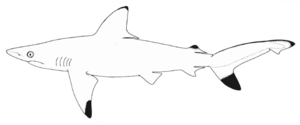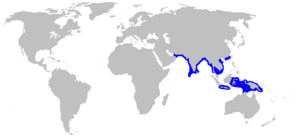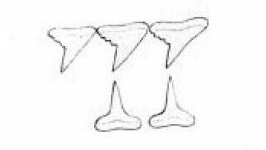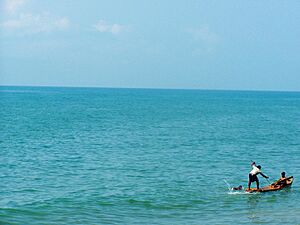Pondicherry shark facts for kids
Quick facts for kids Pondicherry shark |
|
|---|---|
 |
|
| Conservation status | |
| Scientific classification | |
| Genus: |
Carcharhinus
|
| Species: |
hemiodon
|
 |
|
| Range of the Pondicherry shark | |
| Synonyms | |
|
Carcharias hemiodon J. P. Müller & Henle (ex Valenciennes), 1839 |
|
The Pondicherry shark (Carcharhinus hemiodon) is a very rare type of requiem shark. It belongs to the Carcharhinidae family. This shark is small and strong, usually growing to about 1 m (3.3 ft) long. It has a long, pointed nose.
You can tell this shark apart by its upper teeth. They are very jagged near the bottom and smooth near the tip. Its first dorsal fin is large with a long, free tip at the back. Also, this shark has clear black tips on its pectoral fins, second dorsal fin, and the lower part of its caudal fin.
The Pondicherry shark is in great danger of disappearing forever. It used to live in coastal waters across the Indo-Pacific region, from the Gulf of Oman to New Guinea. It is even known to swim into fresh water rivers. Scientists have fewer than 20 sharks to study, so we don't know much about its life.
It probably eats bony fishes, cephalopods (like squid), and crustaceans (like crabs). Like other sharks, it gives birth to live young. The baby sharks get food from their mother through a special connection, like a placenta. The International Union for Conservation of Nature (IUCN) says the Pondicherry shark is Critically endangered. People thought it was extinct since the 1970s. It is likely threatened by a lot of fishing in its home areas.
This shark is one of the 25 "most wanted lost" species. These are animals that Global Wildlife Conservation is trying to find. Pondicherry sharks have been seen in rivers in India recently. One was caught in a river in Sri Lanka in 2011. It was photographed and then let go.
Contents
About the Pondicherry Shark
German biologists Johannes Müller and Jakob Henle first described the Pondicherry shark in 1839. They wrote about it in their book Systematische Beschreibung der Plagiostomen. Their description was based on a young male shark, 47 cm (19 in) long, found in Puducherry, India. They also studied three other sharks from the same area.
Müller and Henle gave the shark its scientific name, Carcharias (Hypoprion) hemiodon. The name hemiodon comes from ancient Greek words. Hemi means "half" and odon means "tooth." This refers to the unique shape of its teeth. Another common name for this shark is the long-nosed shark.
What the Pondicherry Shark Looks Like
The Pondicherry shark is strongly built and has a nose that is quite long and pointed. Its eyes are large and round, and they have special eyelids called nictitating membranes. These help protect the eyes. Each nostril is wide, with a small, narrow bump on the front edge. The shark's mouth is curved and does not have deep grooves at the corners.
Inside its mouth, the upper jaw has 14–15 rows of teeth on each side. The lower jaw has 12–14 rows. There are also one or two small teeth in the middle of both jaws. The upper teeth have a single, narrow, smooth point. This point is surrounded by very large jagged edges on both sides. The lower teeth are thinner and stand straighter than the upper ones. They can be smooth or slightly jagged. The shark has five pairs of long gill slits.
Its pectoral fins start below the fourth pair of gill slits. They are short, wide, and shaped like a sickle with pointed tips. The first dorsal fin is tall and sickle-shaped. It has a very long free tip at the back and sits just behind the pectoral fins. The second dorsal fin is also large and tall. It is located above or slightly behind the anal fin. Usually, there is no ridge down the middle of its back between the dorsal fins. If there is one, it is very small. The caudal peduncle (the narrow part before the tail) has a deep, curved notch at the start of the upper caudal fin. The tail fin is not symmetrical. It has a well-developed lower part and a longer upper part with a notch near the tip.
The shark's skin is covered in overlapping dermal denticles. Each denticle has three ridges that lead to three (or sometimes five) teeth on the edge. The Pondicherry shark is gray on top and white underneath. It has a clear pale stripe along its sides. The pectoral fins, second dorsal fin, and the lower part of the tail fin have clear black tips. The first dorsal fin and the upper part of the tail fin have thin black edges. We don't know the exact biggest size this shark can reach. This is because there are not many large specimens to study. However, it is probably not much bigger than 1 m (3.3 ft).
Where Pondicherry Sharks Live
The Pondicherry shark used to be found widely across the Indo-Pacific region. It might have been common once, as people reported catching it often off India and Pakistan. But now, it is extremely rare. Most of the sharks we know about were found in India. Some were also found in the Gulf of Oman, Borneo, and Java. There are also some less certain reports from the South China Sea, other parts of Southeast Asia (like Vietnam and the Philippines), New Guinea, and northern Australia.
This shark lives in inshore waters, which are close to the coast. Some old reports said it could be found in rivers like the Hooghli River and the Saigon River. These reports might have confused it with a river shark (a different type of shark). But if these reports are true, it means this shark can live in water that is not very salty.
Pondicherry Shark Life Cycle and Habits
The Pondicherry shark is thought to eat small bony fishes, cephalopods (like squid), and crustaceans (like crabs). A parasite found in this shark is a tapeworm called Acanthobothrium paramanandai.
Like other requiem sharks, the Pondicherry shark is viviparous. This means the developing baby sharks grow inside the mother. They get food and oxygen from her through a special connection, similar to a placenta. We don't know many specific details about their reproduction. The smallest known baby shark was a female, 32 cm (13 in) long. This might be close to the size they are when they are born. Sharks become ready to have babies when they are longer than 60 cm (24 in).
Pondicherry Sharks and Humans
The Pondicherry shark is not harmful to humans. People used to catch it for its meat. Fewer than 20 sharks have been kept in museums. Most of these were collected before the year 1900. Because this shark was so rare, people worried it might be extinct.
However, in 2016, the Pondicherry shark was seen again in the Menik and Kumbukkam rivers in Sri Lanka. There are two photos of this species. One was taken from above by nature lovers. The other was taken from the side during a freshwater fish survey. There is a lot of fishing happening in the areas where this shark lives. This fishing is not controlled and is getting more intense. Because of this, the International Union for Conservation of Nature (IUCN) has listed the Pondicherry shark as Critically endangered. They are working hard to find any groups of these sharks that are still alive.




